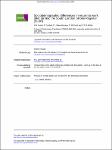Sociodemographic differences in return to work after stroke: the South London Stroke Register (SLSR)
Busch, Markus
Coshall, C.
Heuschmann, P. U.
McKevitt, C.
Wolfe, C. D.A.
Background: Loss of employment contributes significantly to the burden of stroke on individuals and society. There is limited information on factors influencing return to work after stroke. Objectives: To investigate the frequency and determinants of return to paid work after stroke in a multi-ethnic urban population. Methods: Patterns of return to work were examined among people with first ever stroke registered in the population based South London Stroke Register.Employment status and functional outcome (Barthel Index (BI), Frenchay Activity Index (FAI)) were assessed 1 year after stroke. Associations between baseline characteristics and return to paid work were analysed by multivariable logistic regression analysis. Results: Among 2874 patients with first ever strokes in 1995–2004, 400 (15%) were working before the stroke. At 1 year, 94 (35%) of 266 survivors had returned to paid work. Black ethnicity (OR 0.41; 95% CI 0.19 to 0.88), female sex (0.43; 0.21 to 0.91), older age (p,0.001), diabetes (0.25; 0.08 to 0.79) and dependence (BI (19) in the acute phase (0.24; 0.11 to 0.49) were independently associated with lower odds of return to work in multivariable analysis. Better functional outcome at 1 year was associated with return to paid work (p,0.001) but 53% of 161 independent (BI .19) and 39% of 96 very active (FAI .30/45) individuals had not resumed work. Conclusions: There were important sociodemographic differences in return to work after stroke that were independent of clinical and service use variables included in the analysis. A large proportion of patients did not resume work despite excellent functional outcome.
Files in this item
No license information
Related Items
Show related Items with similar Title, Author, Creator or Subject.
-
2009-10-15ZeitschriftenartikelLow ankle-brachial index predicts cardiovascular risk after acute ischemic stroke or transient ischemic attack Busch, Markus; Lutz, Katrin; Röhl, Jens-Eric; Neuner, Bruno; Masuhr, FlorianBackground and purpose: A low ankle-brachial blood pressure index (ABI) is an established risk marker for cardiovascular disease and mortality in the general population, but little is known about its prognostic value in ...
-
2013-05-27ZeitschriftenartikelPrevalence of stroke in adults aged 40–79 years in Germany Results of the German Health Interview and Examination Survey for Adults (DEGS1)Busch, Markus; Schienkiewitz, Anja; Nowossadeck, Enno; Gößwald, AntjeIn the German Health Interview and Examination Survey (DEGS1), data on the prevalence of physician-diagnosed stroke were collected from 2008 to 2011 in a representative population-based sample of 5,901 adults aged 40–79 ...
-
2015-07-24ZeitschriftenartikelModifiable cardiovascular risk factors in adults aged 40–79 years in Germany with and without prior coronary heart disease or stroke Truthmann, Julia; Busch, Markus A.; Scheidt-Nave, Christa; Mensink, Gert; Gößwald, Antje; Endres, Matthias; Neuhauser, HanneloreBackground: Control of modifiable cardiovascular disease (CVD) risk factors has substantially reduced CVD mortality, but risk factor levels in populations may change and need continuous monitoring. This study aims to provide ...

